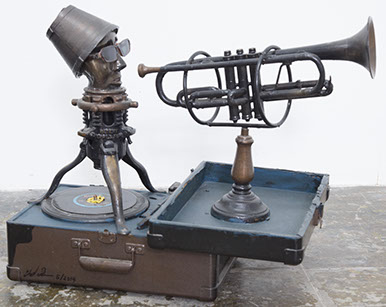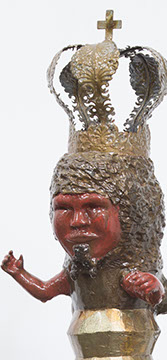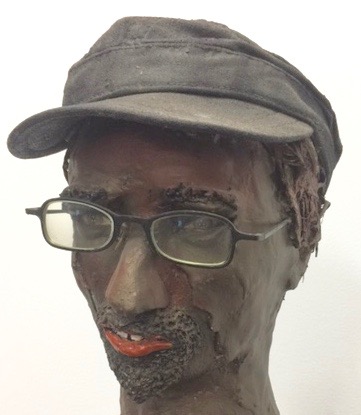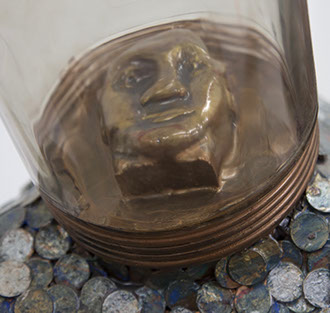STU NEEDMAN
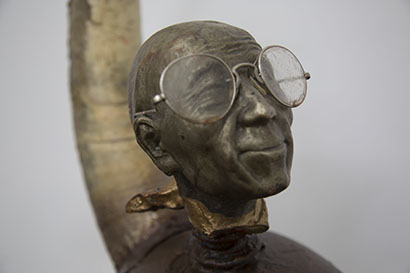
STU NEEDMAN: MONSTER MASH
By Peter Frank
Assemblage, one of the signal techniques of modern – and post-modern – art, was originally lifted from the vernacular. Before its adoption by avant-gardists, “real” artists did sculpture while mere bricolagists just put stuff together. But experimentalists of the early 20th century examined the assemblage approach and found it vital, full of aesthetic and social potential, and ennobled by its very commonality. They took it over as if it had always been a key component of artistic practice. Attaching things to other things wasn’t just fun, it was magical: it released meanings and demons into a discourse dying for surprises. It was an effective way of affronting the complacent and stimulating the dissatisfied. It still is.
Stu Needman knows it is. Playful as his expansively sized, extravagantly built objects in two and three dimensions may be, they mean business. They play with meaning, with material, with color and texture, with presence, and with an abiding sense of poetics. Things rhyme. Things tell stories. Things suggest things. His willingness to wring meaning out of both metaphorical pairing and random conflation can lead Needman down some pretty dark corridors, but even these are animated by a frisson of fun. The artist finds not only the pain and confusion in human existence, but its rollicking absurdity as well.
Needman’s reliance on epoxy resin as both glue and texture – providing a membrane of goopy animation to his already agitated spirits – provokes comparison to Edward Kienholz. Needman may acknowledge Kienholz’s influence, but, beyond the epoxy intoxication, doesn’t much reflect it. Whimsy rarely inflects Kienholz’s sprawling tableaux, while it flavors, even powers Needman’s more self-contained apparitions. Certainly serious in his commentary, Needman gravitates at least as much to the spiritual as to the temporal, and to the jocular as much as to the grim, often balancing all these in delicately choreographed counterplay.
Needman’s special gift – most clearly in his free-standing works, but evident in his assemblage painting as well – is the ability to conjure credible hybrids, fusions of man and beast, beast and machine, machine and monument. He transforms objects into parodies of themselves, mostly by adjoining them to other decommissioned objects and letting such unlikely couplings fool around with one another’s meanings and implicit functions. The half-this-half-that nature of these grotesques puts us in mind both of Frankenstein and Alice Through the Looking Glass. They pick up where the ancient confabulators, the ones who came up with gryphons and cameleopards and all those monsters populating the corners of the world marked “there be monsters,” left off.
A twinge of nostalgia inflects Needman’s incorporation of old-fashioned, once-common objects – baby doll heads, manual typewriters, signage, phonograph records, old license plates, those kinds of attic treasures. But, while this helps establish Needman as a true junkyard-and-street-sale-comber (superficial bona fides, that is, towards his status as assembleur), it is not the basis of his expression. He doesn’t fetishize the antique but recycles it for its iconic significance. As much despite as because of its throwback feel, it now means something all over again.
On balance, Needman’s cacophonies of stuff tend toward the antic. While never ambitiously vast (like Kienholz’s works, for instance), they can loom fairly large – up to human-size – and can embody the frozen moments of what appears to be some pretty vigorous effort. Wheels spin, figurines jostle, hybrid creatures erupt out of some nether world. But there are plenty of quiet, even introverted moments in and among Needman’s assemblages as well. A map-like painting-collage traces a stylized body. An almost naked pole, a little taller than the stem of a bedside lamp, stands quietly – almost forlornly, if we allow ourselves to fancy it a threadbare Christmas tree – draped with some contrasting object or material. Next to the skeletons and rusty missiles dotting Needman’s other, more gestural pieces, these low-key works can seem like afterthoughts, or armatures waiting to be adorned by an efflux of epoxy-flavored madness. But they are as fully self-possessed, as fully complete in structure and inference, as their more elaborate brethren. The Puritans of the oeuvre, they seem from one angle to reproach the rest of Needman’s devices for their oft-lascivious abandon, and from another to move among those tumultuous conglomerations like grace notes or moments of interiority. They return gravity and dignity to a cast of otherwise reprobate characters. They are Needman’s “good” children.
Most of Needman’s children are anything but good. None seems truly evil, vicious, or physically dangerous, but so many of them rock out with abandonment. Needman has bred a “family” of assemblages whose awkward and loopy moments feed into a larger energy, one that propels these improbable grafts into what come off as states of fury, ecstasy, and intense focus. They are part animal, part human, part outmoded technology, in spirit no less than in form. They occupy a fictional realm equidistant from science, theology, the social and the lyrical, very much of the world and very much against it. They’re crazy, like a fox, and Stu Needman is, too. In his realm, there be monsters.
